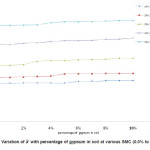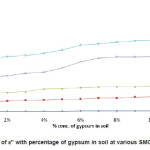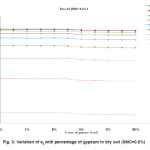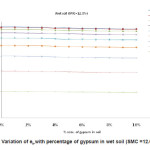Dielectric Studies and Microwave Emissivity of Alkaline Soil of Alwar With Mixing of Gypsum
V. K. Gupta*, R. A. Jangid and Seema Yadav
Microwave Research Lab, Department of physics. Raj Rishi (Autonomous) Government P.G. College Alwar - 301 001, India.
Corresponding Author E-mail: contactvkg@yahoo.co.in
DOI : http://dx.doi.org/10.13005/msri/070227
Article Publishing History
Article Received on : 09 Aug 2010
Article Accepted on : 18 Sep 2010
Article Published :
Plagiarism Check: No
Article Metrics
ABSTRACT:
The real and imaginary parts of dielectric constant (ε' and ε") of alkaline soil of Alwar with mixing of gypsum (0.0% to 10.0%, gravimetrically) determined at 34.50C temperature and at a single microwave frequency 9.78 GHz by wave guide cell method. Mixture of soil and gypsum is prepared at various moistness of soil varying from 0.0% to 12.0%. The ε' and ε" of gypsum are also determined. It was observed that ε' and ε" increases as percentage concentration of gypsum in the soil increase. It was observed that the effect of gypsum mixing on dielectric properties is more significant at higher level of soil moisture content. Further, microwave emissivities are estimated from measured values of ε' and ε" for dry and wet mixture of, soil and gypsum at various observation angles (00-800) for horizontal polarization. It was observed that emissivity of soil decreases as the percentage concentration of gypsum in the soil increases.
KEYWORDS:
Dielectric constant; Microwave remote sensing; Emissivity and alkaline soil
Copy the following to cite this article:
Gupta V. K, Jangid R. A, Yadav S. Dielectric Studies and Microwave Emissivity of Alkaline Soil of Alwar With Mixing of Gypsum. Mat.Sci.Res.India;7(2)
|
Copy the following to cite this URL:
Gupta V. K, Jangid R. A, Yadav S. Dielectric Studies and Microwave Emissivity of Alkaline Soil of Alwar With Mixing of Gypsum. Mat.Sci.Res.India;7(2). Available from: http://www.materialsciencejournal.org/?p=2445
|
Introduction
In Alwar region of Rajasthan salt-affected soils are categorized into two broad classes, viz (i) saline soils; (ii) alkali (sodic) soils, on the basis of the influence of different kinds of salts (i.e. neutral and alkali salts) present in soil. The area of extension for the saline soil is limited but alkali (sodic) soils extension area is quite large. Alkaline soils are characterized by: high pH (> 9), poor soil structure and low infiltration capacity. The primary reason of the alkalinity of soil in Alwar region is higher concentration of salts in irrigation water. The irrigating ground water contains a relatively high proportion of sodium carbonates and bi carbonate. The other salts presented in irrigation water are sulphates, chlorides and of sodium. Generally salts, once introduced by irrigation water infiltrate deep inside the soil at the time of irrigation or in rainy season. After irrigation salt accumulate in the upper soil profile due to transportation by capillary movement of water, which evaporates at the surface leaving behind salts. So in Alwar region, salinity of irrigation water, loss of organic carbon and use of chemical fertilizer are possible reasons for the alkalinity of soils. The problem of alkalinity is further aggravated by low precipitation (<600 mm in a year) and high temperature (>450C in summer) in this semi arid region. Gypsum used to reclaim alkali soils and to treat irrigation water having alkalinity. The Gypsum reduces the alkalinity of soil and makes it soft and useful.
In microwave remote sensing the basic observable parameter at the sensor of radiometer is emissivity, which is related to the geometric and dielectric properties of target.1 Surface roughness and dielectric constant are the important characteristics of soil that influence the strength of emission. The emission behavior of surface or target is governed by its geometrical and dielectric properties with respect to the incident radiation. Further, emissivity also depends on sensor properties such as frequency, polarization of microwaves and the angle of observation. The dielectric constant is an electrical property of matter and is a measure of the response of a medium to an applied electric field. This is a complex quantity that includes both real and imaginary parts. The real component ?determines the propagation characteristics of the electromagnetic wave in the material (i.e. its velocity), imaginary component determines the energy losses or absorption as the electromagnetic wave travels through the material, and is often referred to as the dielectric loss factor of soils. According to various dielectrics mixing models2-6 dielectric constant of an inhomogeneous media like soil is related to dielectric constant of its constituent phases (soil solid, water, air and other material). In case reclaim soil dielectric constant is also depends on the amount of gypsum introduced in soil.
Different models for estimation of emissivity of are prevalent in literature. A brief description and their comparison of these important models are given by calla et al.,7. The Important models are as given.
Zero order non-coherent radiative transfer model proposed by Schmugg et al.,8.
First order non-coherent radiative transfer model proposed byBruke et al.,9.
Coherent model proposed by Stogryn.10
Emissivity Model proposed by Peake.11
Coherent model for multi layer medium proposed by Kong.12
The emissivity model assumes a grey body approximation by assigning a constant soil temperature with depth. Here in present investigation at X-band microwave frequency probable observational depth is not more than a few millimeters of soil13 so we may treat the uniform profile for temperature and dielectric properties for top layer of soil so that soil may be treated as single layer media at X band microwave frequencies. Kirchoff’s reciprocity theorem relates the emissivity to the reflectivity à of the surface if the subsurface temperature profile is uniform (isothermal). So emissivity at any given location is given by the equation (1)
e = 1 – Γ …(1)
The surface reflectivity may be computed from knowledge of the dielectric constant of the medium and the surface boundary condition. The equation (2) gives horizontal component of Fresnel reflectivity by electromagnetic theory [14].

θ is the incidence angle er is the complex dielectric permittivity of soil.
Experimental
Procedure and Materials
For sample preparation the soil of Alwar has been oven dried for twenty four hours at temperature 1100C. The textural composition of soil is as: sand=30.2%, silt=59.7% and clay=10.1%. The soil is divided into eleven groups having percentage concentration of gypsum from 0.0%, 1.0%, 2.0%….10.0%. Each group was divided into five subgroups by mixing with conductivity water 0.0%, 3.0%, 6.0%, 9.0% 12.0%. Total fifty five samples are prepared having different percentage concentration of gypsum (grain size > 70 microns) and soil moisture content (SMC). Initially gypsum was mixed with dry soil then shakes for thirty minutes for even mixing of gypsum and soil. Then desired amount of SMC was mixed and sample kept for twenty four in sealed plastic air tight container to avoid any evaporation. The aim of this operation is to ensure a uniform distribution of gypsum within the soil samples and a well adsorption of moisture by the soil grains and gypsum. We have determined the real and imaginary parts of dielectric constant (e’ and e” ) of above prepared soil samples at 34.50C temperature, at a single microwave frequency 9.78 GHz by wave guide cell method developed by Yadav and Gandhi15. e’ and e” of the soil are measured using shift in minima the of standing wave pattern inside the slotted section of a X-band excited in TE10 mode rectangular wave guide. The experimental set up theory and procedure for the present work is the same as used earlier by other workers.15-16 The dielectric constant (e’) and dielectric loss (e”) for low level SMC and mixture of gypsum and soil are determined using the following equations (3) and (4) respectively

Where λ0, λc, and λd are the free space wavelength, cut off wavelength ( λc=2a) and wave length in the dielectric medium respectively for the wave-guide excited in TE10 mode. αd is the attenuation introduced by per unit length (napers per meter) of the material in side the wave-guide. βd is the phase shift introduced by per unit length in radian per meter of material. Magnitude of the complex dielectric permittivity of the soil is given by the following equation (5)

Results
The Variation of ε’ and ε” with mixing of different concentration of gypsum (0.0% to 10.0%) in soil at various SMC levels (0.0% to 12.0%) is shown in figure: 1 and 2 respectively. It is observed that the ε’ and ε” of soil increases as the percentage concentration of gypsum in the soil increases. The effect of mixing of gypsum on dielectric constant of so soil is more significant at higher soil moisture content. The correlation coefficient (r2) determined between percentage of gypsum in soil and dielectric constant of soil increases as the SMC in the soil increases. For dry soil r2=0.848, when SMC=9.0% the value of r2=0.979 and at SMC=12.0% the correlation coefficient is 0.924. In case of dry soil, hardly any effect of gypsum mixing on dielectric loss was observed. But for wet soil, dielectric loss increases as percentage concentration of gypsum in soil increases. The correlation coefficient (r2) between percentage of gypsum in soil and dielectric loss of soil increases from 0.847 (dry soil) to 0.965 (SMC=12.0%).
Microwave emissivity of soil-gypsum mixture at SMC=0.0% and 12.0% is estimated at different look angles (00-800). The horizontal component of microwave emissivity for dry and wet soil was estimated by emissivity model proposed by Peake[9]. It is observed that horizontal component of emissivity slightly decreases as percentage concentration of gypsum in the soil increase. In case of dry soil, mixing effect of gypsum on emissivity is very small in comparison to wet mixture. Further emissivity of wet soil gypsum mixture is quite small than the dry mixture. Hence, after mixing the gypsum, soil becomes less emissive or more reflective. Emissivity has the maximum value in nadir direction (θ=00) and decreases towards grazing direction (θ≈800).
Figure 1: Variation of å’ with percentage of gypsum in soil at various SMC (0.0% to 12.0%)
Figure 2: Variation of ε” with percentage of gypsum in soil at various SMC (0.0% to 12.0%)
Figure 3: Variation of eh with percentage of gypsum in dry soil (SMC=0.0%)
Figure 4: Variation of eh with percentage of gypsum in wet soil (SMC =12.0%)
Discussions
The dielectric of soil is function of the dielectric constant of its constituents (soil mineral, water, air and other contributing phase as gypsum).There are various dielectric mixing models in literature2-6 predicted that dielectric constant of soil will increases if the percentage of constituent phase of soil corresponds to higher value of dielectric constant increases. The dielectric constant (ε” and ε”) of gypsum, at X band microwave frequency is higher than soil.14-15 In present investigation dielectric constant of dry gypsum was measured 4.34 and 0.04 respectively. So that as the percentage of gypsum in a soil sample (by weight) increases the dielectric constant (ε’ and ε”) of mixture will increases. The effect of gypsum mixing on dielectric constant is significant at higher SMC because grain size of gypsum particles are larger than size of silt and clay (major contribution). The total surface area available for water absorption becomes less due to gypsum mixing (higher grain size corresponds to lower surface area if mass remains same). Hence, more water in mixture behaves in free state in comparison to pure soil. Dielectric constant of free water is higher than bound water.6 In present investigation dielectric constant values determine for soil gypsum mixture is nearly similar to the values predicted by dielectric mixing formula of Looyenga [3]. Further microwave emissivity of soil varies with gypsum mixing, this because of fact that Fresnel reflectivity f soil surface is function of complex permittivity of soil and look angle. As gypsum in soil increases electromagnetic contrast between soil and air increases and soil becomes less bright hence emissivity decreases
Acknowledgements
The authors are thankful to the university grants commission (UGC), New Delhi for providing financial assistance to one of the authors Dr R A Jangid through a major research project to carry out this work.
References
- Ulaby F. T. Moore R. K. Fung A. K., Microwave Remote Sensing: Active and Passive., Artech House,Vol. II. Boston, MA, (1982).
- Birchak J. R. Gardner L. G. Hipp J. W. and Victor J. M., Proceedings of the IEEE., 62(1): 93-98 (1974).
- Looyenga H., Physica., 31: 401-406 (1965).
- De Loor. G.P., Journal of Microwave Power., 3(2): 67-73 (1968).
- Roth K. Schulin R. Flühler H. and Attinger W., Water Resources Research., 26(10): 2267-2273 (1990).
- Wang J.R. and Schmugge T., IEEE Transactions on Geoscience and Remote Sensing., 18: 288-295(1980).
- Calla O.P.N. and Singh R.K., Indian Journal of Radio and Space Physics., 31: 285-292 (2002).
- Schmugge T.J. and Chaudhury B., J. of Radio sci (USA)., 16: 927 (1981).
- Burke W. Schmugge T.J. and Paris J F., J Geophys Res (USA)., 84: 287 (1979).
- Stogryn A., Radio Sci (USA)., 12: 1397(1970).
- Peake W., IRE Trans Antennas Propagation. AP-7: 2582-2590 (1959).
- Kong J. A., The theory of electromagnetic Waves John Wiley and sons Inc, New YorK (1975).
- Raju S. Chanzy A. Wigneron J. P. Calvet J. C. Kerr .Y and Laguerre L., Remote Sensing of Environment., 54: 85–97 (1995)
- Kong J. A., Electromagnetic Wave Theory, 2nd edn. Wiley-Interscience, New York.(1990).
- Yadav J. S. Gandhi J. M., Indian J. of Pure and Appl. Phys., 30: 427-432 (1992).
- Jangid R. A. Neeru. Bhatnagar D. and Gandhi J. M., Indian J. of Pure and Appl Phys., 34: 316-18 (1996).
- Sengwa R. J. and Soni. A., Indian Journal of Radio and Space Physics., 37: 57-63 (2008).
- Sharif S., IEEE Trans Geosci and Remote Sens (USA)., 33: 353 (1995).

This work is licensed under a Creative Commons Attribution 4.0 International License.
 Material Science Research India An International Peer Reviewed Research Journal
Material Science Research India An International Peer Reviewed Research Journal








